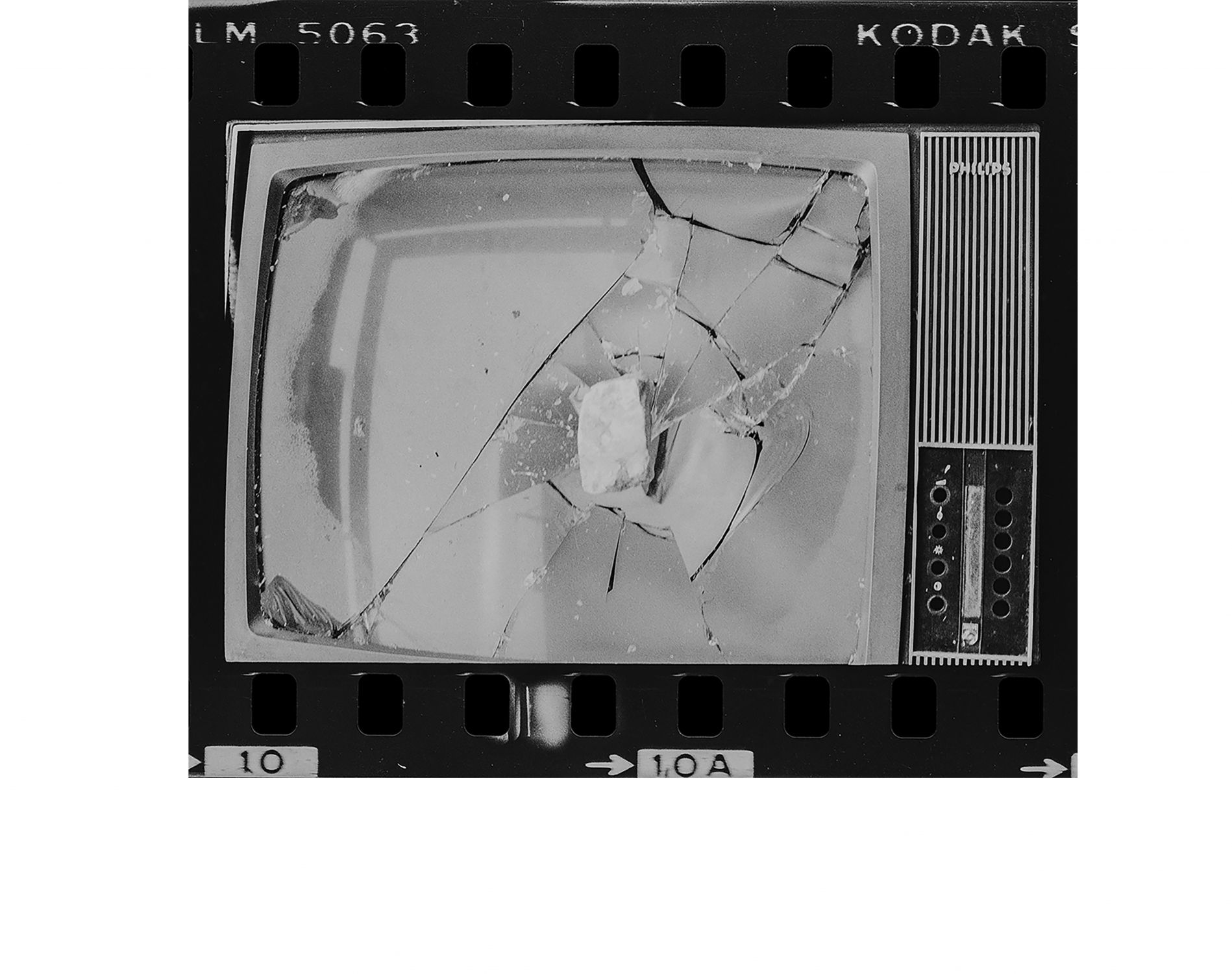Interval, Speculate and Suspension
Manuel BogalheiroBrief notes from Dungeness’ Sound Mirrors (Kent, U.K.)
The evocation of a military complex’s ruins conceived to prevent air attacks – which, in fact, never operated – serves as a starting point to question the interval that gaps the intention of an artwork’s conception. The possibility of error occurrence which might happen within that time interval determines technical and aesthetical implications which may be inferred from the artwork, as well as a more general perspective about the conditions which make that something persists during the elapsed time.
«This then, I thought, as I looked round about me, is the representation of History. It requires a falsification of perspective. We, the survivors, we see everything from above, see everything at once, and still we do not know how it was.» (W.G. Sebald. (1995). The Rings of Saturn, p. 125)
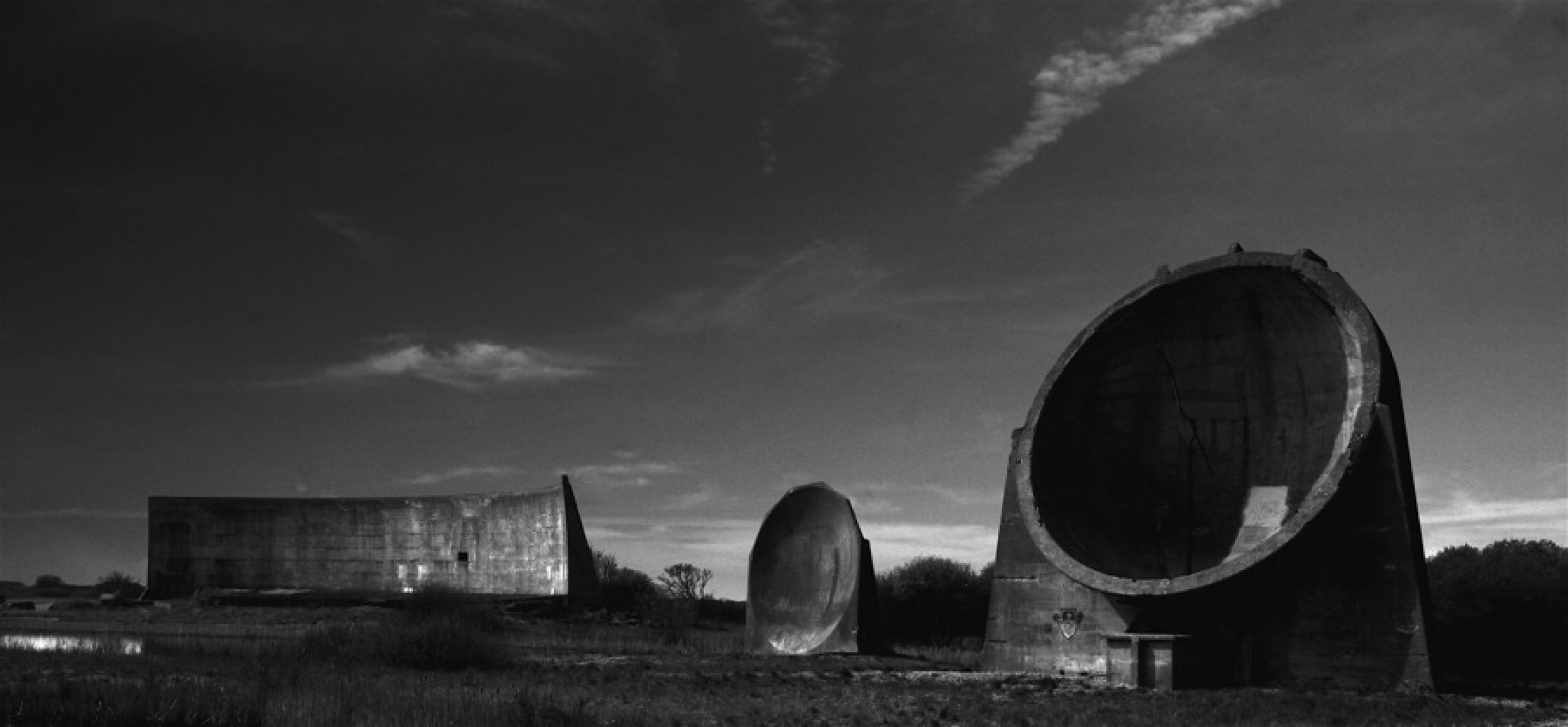
1.
An unusual set of colossal concrete structures colonizes the horizon of Dungeness’ cape, at Britain’s southeast in Kent. A large wall flanks two oval and concave blocks. The visual impact from these structures is not solely resulting from their large scale. Parallel from the archaic that can be seen in them, in their bearing solidity and austerity, the structures present one curvilinear and bulge architecture which coats them with a vanguardist plasticity, as they were abandoned constructions that had come to us as is from the Future. Their imprint in Dungeness landscape suggests an ambivalent strangeness: these structures seem to be out of time. As Tacita Dean mentions, about an artwork that is dedicated to them (Sound Mirrors, 1999), which we will be back to it later on, the landscape composed by those structures «doesn’t seem to work on now»[1].
The structures that we are referring to would be known as Sound Mirrors.
Conceived during WWI, when the danger of the newer air attacks created new challenges to national security, the structures were designed as huge alert devices who could detect, at a considerable distance, the sound of German airplanes coming closer to the British coast[2]. As a kind of pre-radar monitoring system, these structures would be designed to capture sound, as if they were huge stethoscopes. The concave shape would concentrate sound waves in these acoustic mirrors and an operator, in the base of the structure would analyze those waves and issue an alert. WWI would end before this project’s completion and the structures would only be built between 1928 and 1930. Defrauding the initial expectancy, its supposed efficiency quickly showed flaws. Its auscultation power, though being able to capture sound, didn’t provide enough detail in order to distinguish between the sound of a boat, local traffic, a group of people in a picnic or an airplane. In short, the project failed as soon as it was perceived the detachment towards what was the main essential objective: distinguish what could be hostile, from what wasn’t.
Any afterwards investment in the search of a correction for this error would also end up unjustified. 20th century’s 30s would assist the appearance of radar technology with its revolutionary monitoring power, and Dungeness’ mirrors, instead of becoming a research project or being enhanced, would become, right from start, obsolete structures condemned to be forgotten. The military services still maintained them active for a while, but completely abandoned them shortly after a while. The demolition order, meanwhile issued, was disregarded as WWII triggered. Sentenced to firmly rest in Dungeness horizon, but disabled to probe the signs of 20th century historical traumas, the mirrors would solemnly stay, even without any use, at least from a military perspective, reflecting the sound of the nearby seashore.
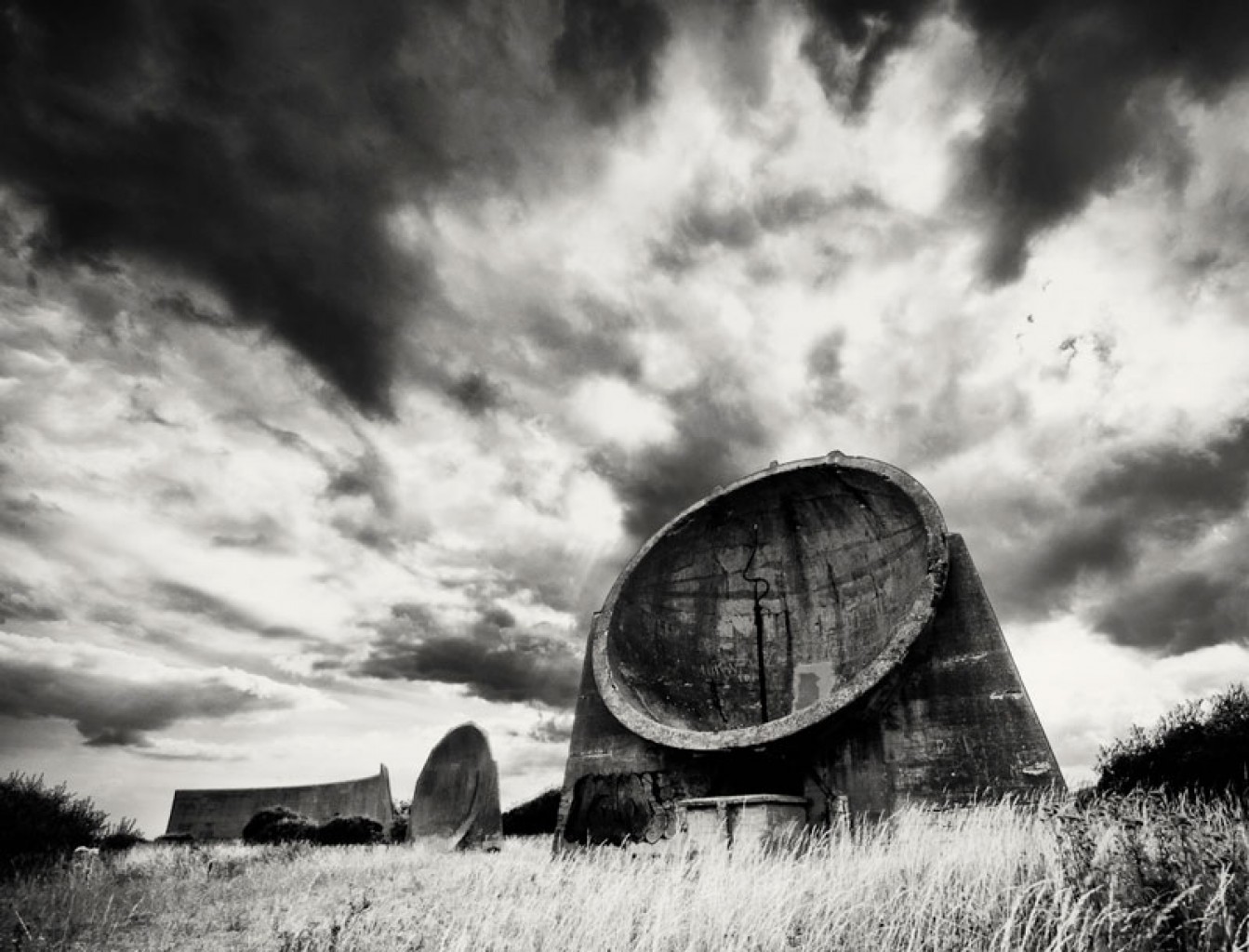
2.
The technical fiasco of Dungeness’ sound mirrors starts to reflect the error margin whenever one plays within the irreducible interval between theoretical conception and the practical realization of an object. The passage from the abstract idealization of one project to its concrete materialization will always enclose that intrinsic discontinuity entailed when putting something in the world and in the real’s limits. The technical investments on calculus, on applied mathematics, on science for verification and forecasting work painstakingly in the search of reducing, almost to an insignificance, that interval. Nevertheless, in absolute terms, they aren’t able to eliminate it completely. A technical object, to work and to affirm itself as an useful instance, can’t escape to the conservation of a certain undetermination margin and contingency[3], which enables the necessary reaction and opening to integrate, in its functioning, unforecasted variables or commands that exceed the strict plan of theoretical conception. In a given way, this was one of the essential problems that triggered cybernetics studies, in the mid 20th century. The analysis of the automation processes, which oriented the dynamics of control of Man over machines, looked for an equilibrium in that interval’s margin, in a way that the potential undetermination of the object’s functioning doesn’t exceed or violate its initial abstract project. Enlightened by these ideas, sound mirrors example is, however, more peculiar. The early diagnosis of its uselessness exposed that interval in a more explicit way: the deviation margin between what was intended and the effects of what was realized revealed irreparable.
The idea of interval, or the potentiality towards a deviation that can result, negatively, in failure or, positively, in capacity of answering has been, in several forms, affirmed as a central idea in diverse domains through 20th century. Beyond of the technical domain, in the art domain, for instance, the idea of artistic coefficient is still paradigmatic, as affirmed by Marcel Duchamp: «the arithmetic relationship between ‘what is not expressed, but that was projected to be’ and ‘what is expressed unintentionally’»[4]. When radicalizing Duchamp’s idea, and if putting an emphasis in the struggle intrinsic to the creative act which disables the author of expressing completely its intention, one can understand that all artworks are a certain kind of failure between intention and realization.
But in a century imprinted by tension between a techno-scientific evolution and the crisis of the positivist utterances, the evocation of the idea of interval can be even more transversal. The sound mirrors of Dungeness, in the way they expose the failed deviation between intention and realization, refer to that most primal interval: the one of conditions of access to the real. Being the initial objective the detection of potential enemy air attacks, of filtering it from an universe of possible sounds, the mirrors would end up failing that filtering, ending up to catch the sound chaos that surrounded them. It is, once more, the frustration of seeing the illusion that it could be possible matrixing the real in a exhaustive way from where it could be extracted only what was supposed. The resistance in accepting that the world exceed us and that, consequently, our capturing devices will always tend to the insufficiency manifests dramatically here. The difficulty won’t reside in the capturing conditions. The problem is placed in the possibility of ordering and categorizing of what is being captured, unsurpassable such is the absolute annulation of those discontinuities[5].
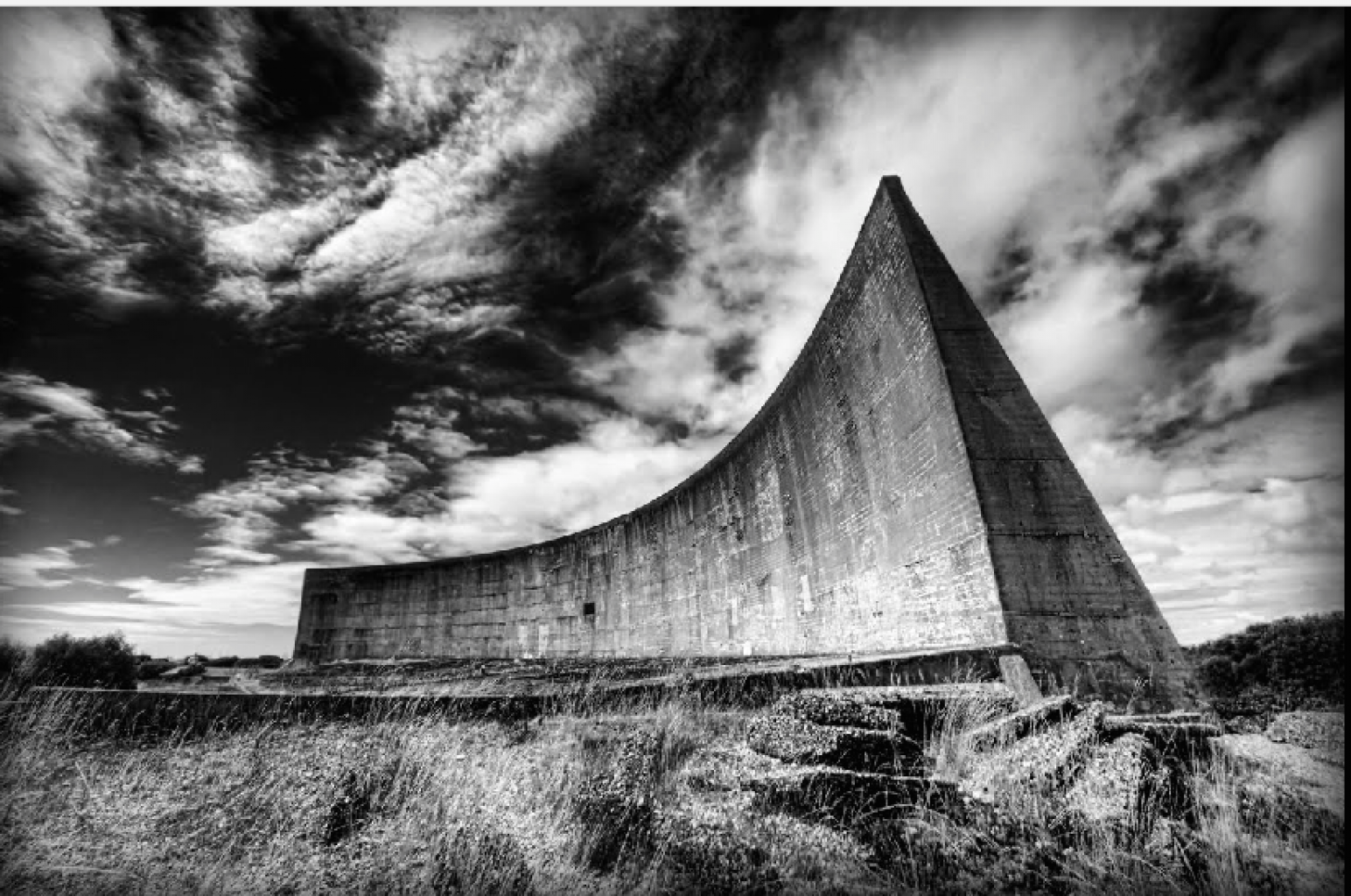
3.
The notions of interval and discontinuity, besides being implicated in the failed destiny of Dungeness’ structures, also echoed the symbolic weight that was assigned to them, while as mirrors – by its own concave configuration of its architecture and by their function of reflecting sound. The specular devices, from the river in which Narcissus was fixed to the nowadays adorned mirrors, entailed one division originated in the way that they unfold the real and multiply it[6]. The effect of something that reflects itself, that moment when the real is given back to us, corresponds to a symptomatic example of an interruption. In that effect, we are faced with a kind of fold that doesn’t add nothing to reality, but that reproduces it and gives it back.
Mirrors are, hence, the major symptom of that world’s originary division, not only between objects and their duplicates, but between the realm of usefulness and the real of uselessness.
The usefulness, belonging to the order of technical, must add something to real, must build something. The uselessness, from the order of aesthetic, can only symbolically reproduce the real, only duplicating it, leaving to individual subjectivity the responsibility of lasting its effect. Oscar Wilde gave consistency to this dualism when assertively wrote that «all art is quite useless»[7]. Before this basal sentence, the irish writer fundamented his hypothesis: «We can forgive a man for making a useful thing as long as he does not admire it. The only excuse for making a useless thing is that one admires it intensely»[8].
Lasting this reading, also Dungeness’ mirrors can reflect this dualism and the interval that separates the realms of usefulness and uselessness. Conceived as alert devices, the usefulness of these structures resided in making that system effective, giving the ability to prevent air attacks. That would be its role in the way of adding or building something, of artificially lasting the relationship with the real, as any other technical invention does. However, at the moment when that supposed usefulness was understood as a failure, when it was proven the system’s errors, the sound mirrors freed themselves from any utilitarian characteristic. It was that the transformation moment when they were made available, now without any use, to be iconified or aestheticised as symbolic buildings between the condition of monument and ruin.
In this phase, they could only replicate aspects of the real, reflect it or reproduce it as any aesthetic object. They could last Dungeness’ landscape but they won’t add anything to it in terms of an utilitarian end. Indeed, the name mirrors, which would be given to these structures, encloses the premature revelation that its uselessness could only make them aesthetic instances. Forgotten from the military strategy, they couldn’t be through the symbolic reach which would be assigned. That reach, within other quotable examples, would constitute the motif of the artwork which Tacita Dean would dedicate to these structures in her 1999 movie Sound Mirrors[9]. During approximately seven minutes in black and white film, Dean’s movie shows several angles of the concrete structures, decontextualizing them from their initial possible utility to insist in the tension between their decadence and their remaining aura. The sound that goes along with the images was integrally recorded through a microphone embedded in the largest of the mirrors, giving the possibility of testify the acoustic that these monoliths continue to reflect in the surrounding environment of Dungeness.
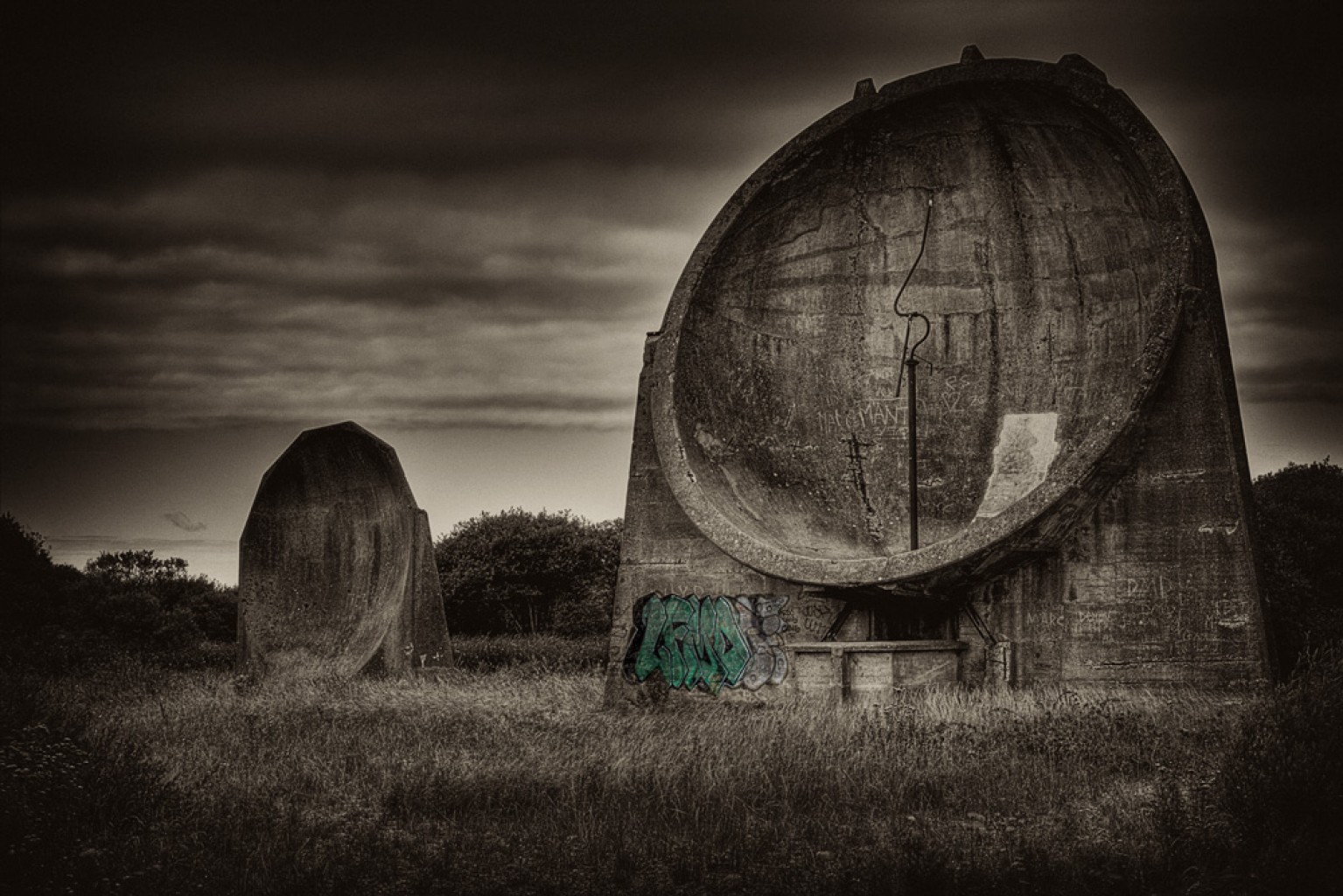
4.
Despite the initial technical failure, the mirrors resisted to oblivion and their memory was inscribed in a form of symbolic register. Paradoxically, it was their technical uselessness that made, rightly, that they were not forgotten.
Recovering Walter Benjamin’s ideas about the transition from the obsolete to the aesthetic, Dungeness’ sound mirrors were inscribed as a collectionist gesture. For the german author, the collector is the one that has interest for objects that don’t any longer work and, in that utopian gesture of compilation and admiration, can free them from the utilitarian and mercantile character, which the cynical element of history imposes to them[10]. From Benjamin’s readings, Rosalind Krauss extends those ideas and adds that «nothing brings the promise encoded at the birth of a technological form to light as effectively as the fall into obsolescence of its final stages of development»[11]. What Krauss’ note seems to add to Benjamin’s thesis is that, in the conception of technological objects, even in the more abstract stage of their planning, there an aesthetic dimension or, at least, a promise that exceeds the supposed efficiency of their functions and results to be obtained. And, if such promise is contained since the project’s inception, it’s in the error or failure that its revelation manifests more prominently.
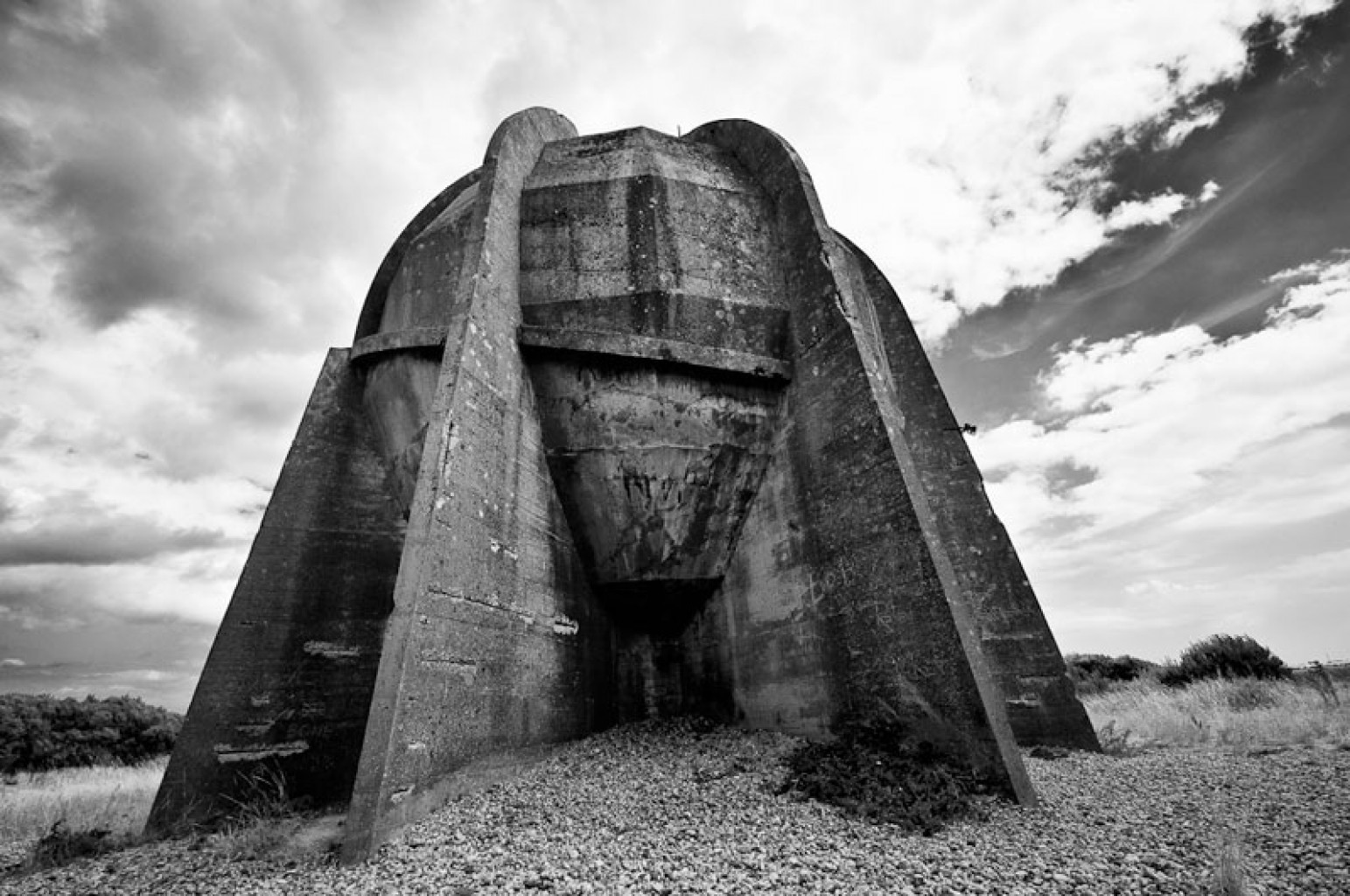
The conception of Dungeness’ sound mirrors, even that developed in the military strategy ambit, surely that didn’t reflect criteria that weren’t strictly functional. One could think that, for instance, in the sensitivity to the place and to the Dungeness landscape, in the conditions that such insertion happened, or in the configuration that their architectonic design represents in that place’s extension. However, that criteria is manifested in a more prominent way when the functional questions are eliminated or given as broken. It’s in the reframing that these structures expose a net of connections that didn’t exist before their appearance and persisted beyond their capacity to operate technically. The technical failure thickened the reticulation of several realities which reflect simultaneous: Past and Present, technical and aesthetical, efficiency and admiration, deviation and expansion. There are the connections, now perfectly excluded from the technical order, which enabled facing that place colonized by the sound mirrors as an exception point[12].
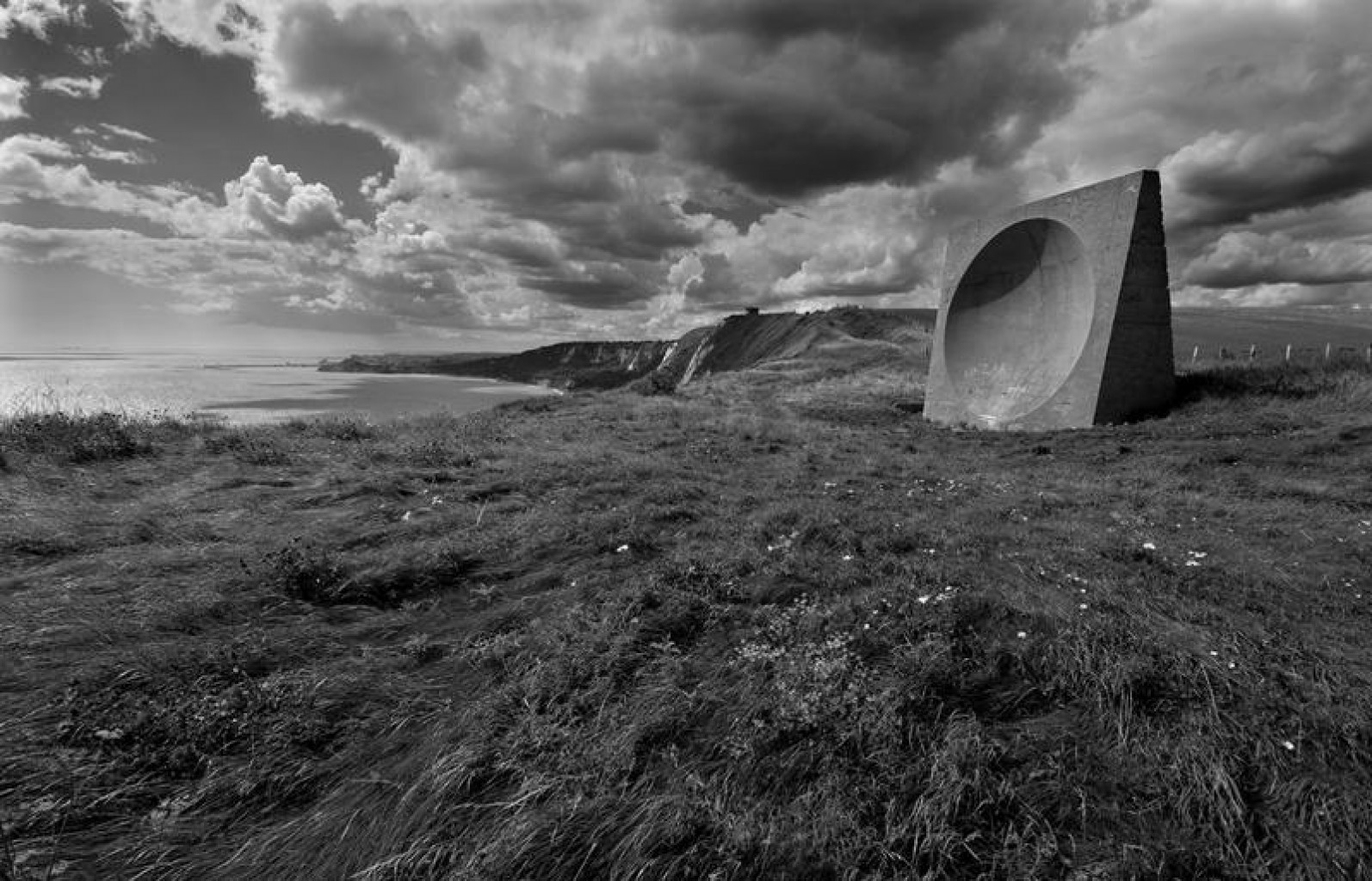
5.
Hal Foster, in a text about contemporary art’s archivistic impulse, considers Dungeness’ sound mirrors, mediated by Tacita Dean’s camera, a failed futuristic vision: when aestheticised «serve as found arks of lost moments in which the here-and-now of the work functions as a possible portal between an unfinished past and a reopened future»[13]. Hal Foster’s sentence plays with timeline’s heterogeneity and its always incomplete character or, more radically, with something that can exceed that timeline. It’s in this excess that the artwork must be considered. If technique, in constant efforts towards results efficiency tries to shorten intervals, aesthetics only tries to suspend them, revealing the insufficiency in the chronological measure. In that suspension gesture, with a discrete character, as the mirrors that fold the real and only replicate it, the objects, the buildings, monuments or ruins can only be perceived through the multiplicity of chronological angles which form what they have been and what they didn’t have. Going back to Duchamp and to his famous notes about the creative process, «his struggle toward realization is a series of efforts, pains, satisfaction, refuses, decision, which also cannot and must not be fully self-conscious, at least on the esthetic plane»[14].
Despite the tensions and the contradictions implied, what was realized is, however, what remains. The suspension, with all that can reveal aesthetically and with all its questioning power, cannot be permanent so, in that case, would lose its effect. The real duplication, which art works, also faces us with the importance of, through the work of technique, if it continues to add something to real, of build and mold tectonically – even with error vicissitude. It’s this add that, together with failures, constitutes the timeline continuum. The mark in the horizon of the old Dungeness’ sound mirrors persists in re-evocation of that constructive impulse or tectonic. The solemnity as they resist to time corrosion reminds us that our own existence depends on the realizations and what we can retain from them, even when they fail. Otherwise, we would block in the suspension’s interval or we would dissolve in the timeline[15]. The act of doing, even with the possibility of failing, it’s the ultimate gesture against that abyss of time dissolution or against the hypothesis, possibly unbearable, that if the Present had a limit then certainly would be dissociated from the Past.
Footnotes
- ^ DEAN, Tacita. (2003). «Sound Mirrors» in Selected Writings. Paris: ARC/Musée d’Art Moderne de la Ville de Paris, n.p.
- ^ The project was realized in the Air Defense Experimental Establishment ambit and was supported, in a large way, in William Sansome Tucker’s research. Cf. SCARTH, Richard N. (1999). Echoes From the Sky: A Story of Acoustic Defence. Hythe: Hythe Civic Society.
- ^ The expression is borrowed from Gilbert Simondon, which develops it extensively through his book Du mode d'existence des objets techniques. Paris: Aubier, 1989.
- ^ DUCHAMP, Marcel. (1957). «The Creative Act». Art News, Vol. 56, n.º 4.
- ^ Certainly that the radars, which substitute the mirrors, also left dimensions of the real for mapping or monitoring.
- ^ Jorge Luís Borges from the mirrors made one of the main themes of his literary work. From several excerpts that could be quoted there’s one with a particular relevance towards this essay; a the famous passage «the mirror and the copulation are abominable since they multiply the number of men» («Tlön, Uqbar, Orbis Tertius», Ficções. Lisboa: Quetzal Editores, 2013) or the verses of the poem, named The mirrors, in which he writes about them: «Infinites I see them, elementary / Executors of an old pact / Multiplying the world as a generative act / Sleepless and fatal».
- ^ WILDE, Oscar. (1890). The Picture of Dorian Gray. Oxford: Oxford University Press, 1981, p. XXIV.
- ^ Ibid.
- ^ DEAN, Tacita. (2003). «Sound Mirrors» in Selected Writings. Paris: ARC/Musée d’Art Moderne de la Ville de Paris, n.p.
- ^ Cf. BENJAMIN, Walter. (1931). «Unpacking My Library» in Illuminations (Tr. Harry Zohn). London: Fontana, 1973.
- ^ KRAUSS, Rosalind. (1999). A Voyage on the North Sea – Art in the Age of the Post-Medium Condition. London: Thames & Hudson, p. 45.
- ^ About this local exceptionality of Dungeness, Tacita Dean writes, in the introductory text of her work Sound Mirrors: «It is an empty desolate place, and I’m sure it is this desolation that makes Dungeness so utterly attractive: that in its emptiness it can become so full». DEAN, Tacita. (2003). «Sound Mirrors». Selected Writings, Paris: ARC/Musée d’Art Moderne de la Ville de Paris, n.p.
- ^ FOSTER, Hal. (2004). «An Archival Impulse». October, n.º 110, Fall 2004, p. 14.
- ^ DUCHAMP, Marcel. (1957). «The Creative Act». Art News, Vol. 56, n.º 4.
- ^ The fear around the hypothesis of a dissolution in the time continuum relates, in the limit, with the indispensable character of memory. W.G. Sebald synthesised masterfully this question: «And yet, what would we be without memory? We would not be capable of ordering even the simplest thoughts, the most sensitive heart would lose the ability to show affection, our existence would be a mere neverending chain of meaningless moments, and there would not be the faintest trace of a past. How wretched this life of ours is! – so full of false conceits, so futile, that it is little more than the shadow of the chimeras loosed by memory.» SEBALD, W. G. (1995). The Rings of Saturn. Frankfurt: Eichborn / London: Harvill Press, 1998, p. 255.
